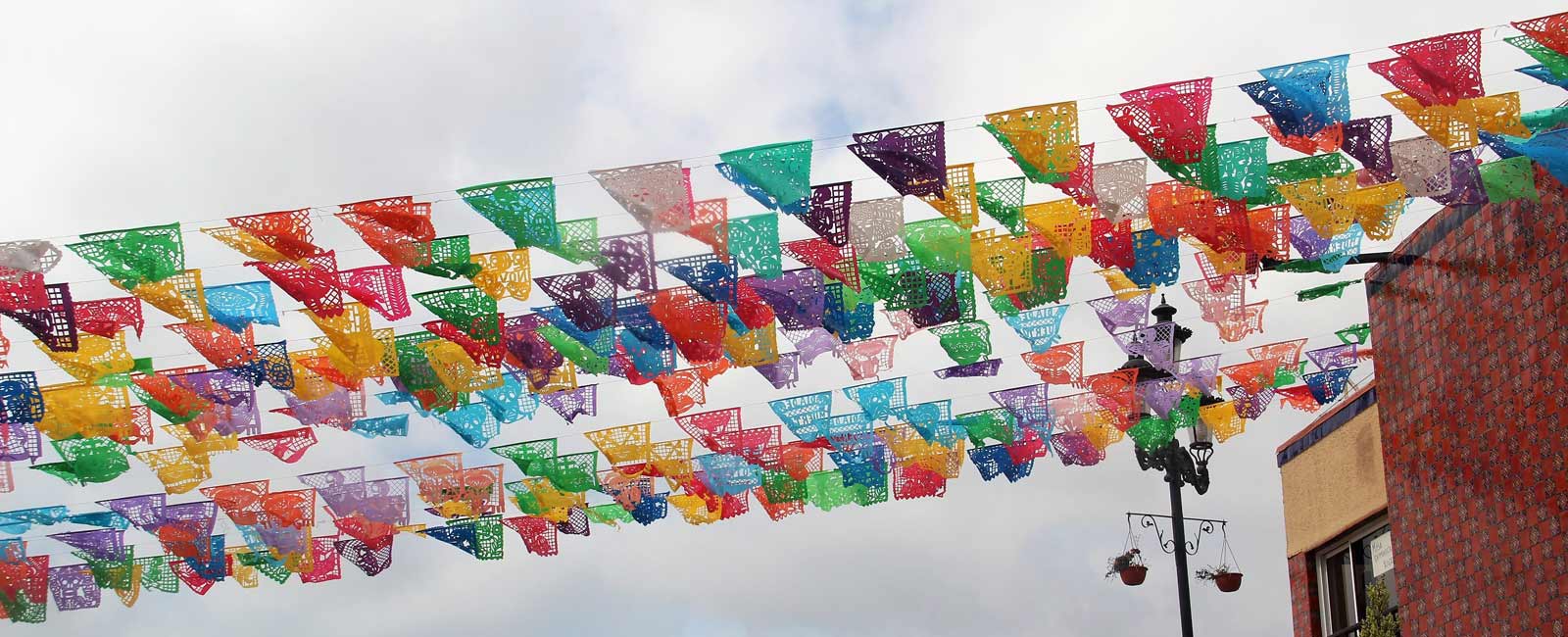
Francis Parker Exploring South East Asia
Tuesday, Feb. 17: Reflections on Cambodian Fortitude: Reconciling a Painful Past and a Moment of Bliss
She is dressed like an ordinary young woman, albeit a glamorous one, wearing a professional-looking red dress and blazer. Suddenly, her face twists into an expression of intense grief as she opens her mouth to smote, or sing a funeral song. The high notes sound like a beautiful cry, while the low, throaty notes are reminiscent of a lullaby. The smote is typically performed at funeral ceremonies or deathbeds because it is through this particular song that souls can travel to heaven after death. At the same time, the smote provides peace and solace to the souls left living. It was through this ancient art form that we were introduced to the most difficult day our group has faced thus far: the visit to Tuol Sleng.
This prison lies in the middle of Phnom Penh, and it was the center for the Khmer Rouge’s torture and killing of Cambodia’s intellectuals. We entered the compound and immediately felt the grimness of the buildings, whose only decorations were garlands of barbed wire. We were led into a small, stuffy room to hear the smote performance, and as we listened, we were stared at by the eye sockets of rows and rows of skulls. When it dawned on us how recently these skulls were found (for many still had yellowing teeth in the broken jaws), and as the sounds of the funeral chant welled around us, the experience became even more poignant than we had expected.
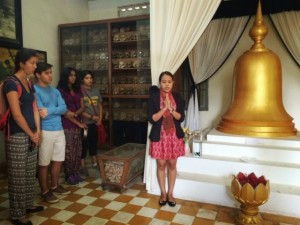
When our tour of the prison began, the first striking fact of the day was that the prison compound was originally built as a high school. Though the reasons may have been more practical than symbolic, this “coincidence” could not be ignored. We saw how blatantly the Khmer Rouge targeted people, places, and symbols of learning, and we realized as we walked along the hollow concrete halls that the Khmer Rouge was targeting our people. We are young intellectuals, exploring the world in order to learn. Our families have put an emphasis on education. We are the very population that would have been put in Tuol Sleng, our values attacked and obliterated. What happens to a culture when all of the educated people are destroyed? Thankfully, the Khmer Rouge did not last long enough for us to find out, but even Pol Pot (hypocritically) admitted to needing artists and learned people: out of 20,000 prisoners at Tuol Sleng, only seven survived, and all were portrait artists, translators, and other skilled workers who could keep the government running. However, even though seven were spared, their families were not so lucky. As our tour guide described the horrific devices used against prisoners, our eyes wandered around the ghostly cells, only to land on the most disturbing sight any of us had encountered. There were bloodstains. On the floors, the ceilings, and the walls. It is hard to articulate just how intense that sight was, but the blood of innocent people that remains tattooed on the surfaces in the prison shocked even the most resilient among us. As a group, we shared the burden of the visit by taking breaks and listening to the guide in shifts. It was as if we silently understood that each of us needed a break at certain points, and we supported each other through the process. While this is at a minuscule scale compared to what Cambodians went through, it is comforting to think that perhaps there was a similar kind of support among prisoners. Although they could not take breaks from the horror in which they were living, we still got the sense that prisoners held on to their humanity and dignity for as long as possible, and that resilience lasts to this day.
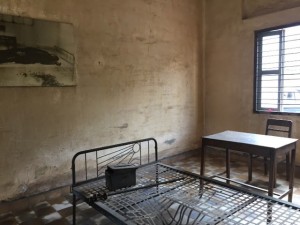
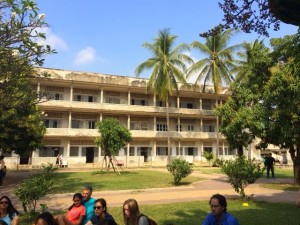
On the note of resilience, we had the incredible opportunity to meet with the two remaining survivors of the prison. The situation seemed so powerful, and yet the presentation was bizarre. As our group moved towards where the survivor was set up, we were bombarded by the street-vendor line, “Lady, lady, you want to buy?”, referring to the survivor’s memoir. It seemed so inappropriate in the middle of the courtyard of the Tuol Sleng prison, but the survivor was right in front of us. The strange part was that he seemed to be selling his story of intense suffering to turn a profit. While the profits went to an organization to help victims of the Khmer Rouge, it felt wrong to see a sign reading, “They tortured me, they poured salt water in my wounds, they killed my wife,” as if he was commodifying his pain. Perhaps we are attuned to it, being part of a consumerist culture, but the situation felt, nonetheless, bizarre.
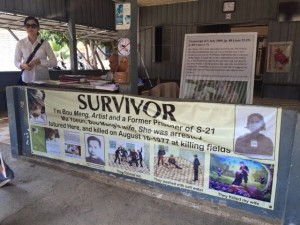
We left the Toul Sleng prison and bussed to Bophana Film Center, where an employee spoke to us about the center and their goal for film in Cambodia. The Khmer Rouge had tried to destroy anything that made people individual, which included family pictures, many of which were lost during the regime. The Film Center works to preserve, protect, and collect these lost family pictures from the Khmer Rouge. The Film Center’s main efforts, however, are in the direction of films, both protecting films from before the Khmer Rouge and producing films to fill the gaps of information about the Khmer Rouge. We were able to view a film in the Center called The Missing Picture, a full-length film that sought to recreate the missing pieces of the past of a man who lived and survived during the Khmer Rouge. Having lost his whole family during the regime, through clay figurines and real footage of the Khmer Rouge the survivor was able to formulate a beautifully symbolic, intense, and longing story of his lost childhood. It was deeply personal and yet incredibly universal in such that it represented the real-life pains of the survivor aching for his family as well as representing the suffering that every Cambodian person experienced during the horrors of the Khmer Rouge. Having come straight from the Toul Sleng Prison, seeing this movie further broadened our understanding of the Khmer Rouge and how the suffering was widespread throughout the entire country. Both intellectuals, such as the people who were tortured in the prison, and the peasants of the countryside, such as the survivor in The Missing Picture, experienced great pain during the Khmer Rouge. A central theme to these two experiences we had today was the idea of what it means to be human–how the Khmer Rouge dehumanized Cambodian people, and the silent rebellion of the people in response. The Khmer Rouge sought to control everything, even death, leading some people such as the survivor’s father and some prisoners from Toul Sleng to accept that they could no longer control their lives, which in turn led them to try to control their death through suicide.
The tone of the day changed completely after lunch, when we embarked on our built-in mental respite from the intensity of the morning. We went on a river cruise, courtesy of Charley Todd. We met Charley through Cambodian Living Arts, of which he is the board president, and he allowed us to experience a new part of Cambodia. A brief background of Charley: Charley is a man in his 70s and is orginally from the East Coast. He adopted a Cambodian son and later in 2000 began to live in Phnom Penh to facilitate his work with Cambodian Living Arts as well as to be closer with his family. His son is married and has two young sons, who also live in Phnom Penh. Charley lives in Cambodia eight months of the year and is almost like an adopted Cambodian. He is fluent in Khmer, rents a guest house off the Mekong, and is an active member of his son’s family. He welcomed us to his home and allowed us to experience the Mekong River on a rented boat, named “Charlie” due to a serendipitous coincidence.
The cruise down the river, followed by relaxation at Charley’s pool in his beautiful wooden house on stilts, was a time of pure happiness. It was an end to the day none of us could have imagined, given how the morning began. We spent the trip to his house learning a famous Cambodian song, similar in tune and popularity to “She’ll Be Comin’ Round the Mountain When She Comes.” We played for hours in the pool with Charley’s adorable grandsons, who spoke French and had extensive knowledge of the solar system at ages six and seven. On the boat trip back, we turned the rickety wooden vessel into a nightclub from the past, dancing to “Build Me Up Buttercup” and “September” with the Cambodian musicians and guides.
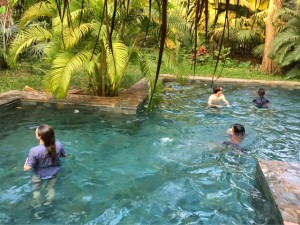
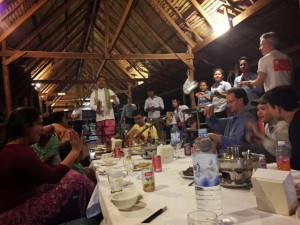
The blissful end to our day happened by design because our guides and teachers recognize the need to take a mental break from the horrors that afflicted this beautiful country less than half a century ago. However, our day of contradictions showed us the kind of choice Cambodians face in this modern time. There are those who dwell on the past: Cambodian Living Arts attempts to revive ancient art forms that were destroyed from the Khmer Rouge, and the smote singers talked about how their art form was dying because the new generation was not interested. They seemed to be struggling to keep the past alive. But every day they have to face the heaviness we felt when walking around Tuol Sleng. They have dedicated their lives to the past and in doing so have forgotten to give themselves that break we so desperately needed by noon. While it would be tragic to lose the richness of Cambodian culture, perhaps the younger generation’s rejection of smote and other traditional art forms is a coping mechanism. It is their way of cruising down the river, away from the painful past, in order to embrace a peaceful future.
–Olivia Ghosh and Nicole Keeney
